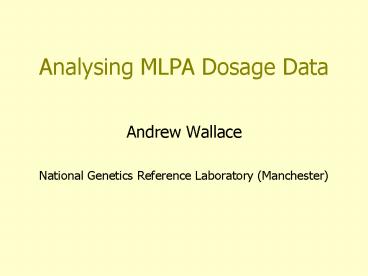Analysing MLPA Dosage Data PowerPoint PPT Presentation
1 / 14
Title: Analysing MLPA Dosage Data
1
Analysing MLPA Dosage Data
- Andrew Wallace
- National Genetics Reference Laboratory
(Manchester)
2
Problems with Dosage Analysis
- Dosage data is quantitative continuously
variable - Diagnostics requires a binary answer e.g. is
the patient sample normal? Yes/No - How can we analyse dosage data to provide the
clear cut Yes/No answers we want?
3
Problems with Dosage Analysis
- Problem is compounded by the increasing numbers
of analyses in newer tests e.g. MAPH and MLPA - WHY?
- If we use a standard statistical measure of
significance for each exon tested the probability
of a Type I error increases - Alternatively if we use an arbitrary cut-offs we
fail to take into account variabilities between
loci - Sample sizes limited to current experiment too
much variability between experiments
4
Dosage Quotient (DQ) Expectations
- We have one advantage - we know what results to
expect i.e. for autosomal loci - normal expect a DQ 1.0
- deleted then we expect a DQ 0.5
- duplicated then we expect a DQ 1.5
5
Modified MLPA Dosage Analysis
- Used a small series of reference normal samples
(5) run at the same time as experimental samples
to determine DQ variability of each amplimer - The deleted and duplicated values are inferred in
relation to the control measurements (0.5x or
1.5x) - Use the t statistic to estimate agreement with
three hypotheses (i) deleted (ii) duplicated
(iii) normal - t statistic must be used rather than standard
deviations due to small sample size
6
DQ likelihood distribution
p
7
t-distributions of DQ values
Good quality data
p
Poorer quality data
p
8
Calculation of relative likelihood
Good data normal DQ
DQ 0.9 p(2n) 0.40 p(n) 0.0009 p(3n) 0.0006
9
Calculation of relative likelihood
Good data deleted DQ
DQ 0.7 p(2n) 0.0007 p(n) 0.03 p(3n)
0.00009
10
Calculation of relative likelihood
p
Poor data ?deleted DQ
DQ 0.7 p(2n) 0.007 p(n) 0.021 p(3n) 0.0007
11
Good Quality Normal Data Showing Typical
Variability
MLH1 Exon 5 although prob of deviation from
normal is low (1.2249) 1473561 Normal Deleted
- thus not Deleted 7971 NormalDuplicated - thus
not Duplicated
12
Good Quality Data Giving an Unequivocal Odds
Ratio for a Deletion
MSH2 Exon 4 112460 NormalDeleted thus
Deleted 31 NormalDuplicated can discard this
hypothesis due to evidence for deletion
13
Poor Data Leading to Equivocal Odds Ratio
MLH1 Exon 9 34191 Normal Deleted Thus Not
deleted 31 NormalDuplicated ?Normal
14
MLPA Dosage Analysis Spreadsheets
- CONCLUSIONS
- New analysis which can attach a meaningful
probability to dosage data more objective - Unsuitable for detecting mosaic
deletions/duplications will give equivocal odds
ratios - Can be applied to other quantitative PCR assays
- Spreadsheets designed for BRCA1, HNPCC, VHL and
DMD available from me eventually from NGRL
website (www.ngrl.co.uk)

